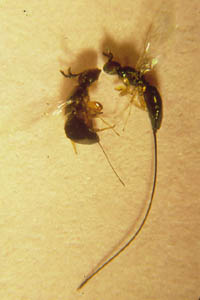•
Machado Home
• Research
Fig mutualism
Drosophila
Trypanosoma
• People
• Publications
• Teaching
• Links
• Research
opportunities
and contact information |
Research on the Fig-fig wasp mutualism
Figs (Ficus sp., Moraceae) and their pollinating wasps (Agaonidae, Chalcidoidea, Hymenoptera) constitute one of the most extraordinary pollination mutualisms known. The fig depends completely on its pollinating wasp(s) for reproduction and the wasps on the fig for completing their life cycle. In addition to the pollinating wasps, a diverse community of non-pollinating wasps also exploits figs. Individual host fig species may harbor many different species of non-pollinating wasps, and related host figs may possess very similar assemblages of these species. We have conducted a diverse range of studies on the evolution of this fascinating mutualism (see our publication list). Our current interests are:
1. We have developed genomic resources to study patterns of divergence and co-diversification in figs and fig pollinating wasps. An important aspect of this work is  testing the hypothesis that gene flow between monoecious fig species may be prevalent. This hypothesis arose from the observation that a significant fraction of fig species (>30%) is pollinated by multiple pollinating wasps, some of which are not closely related (reflecting host switches) and some of which may also be associated with more than one fig host (reflecting potential current gene exchange between fig hosts). testing the hypothesis that gene flow between monoecious fig species may be prevalent. This hypothesis arose from the observation that a significant fraction of fig species (>30%) is pollinated by multiple pollinating wasps, some of which are not closely related (reflecting host switches) and some of which may also be associated with more than one fig host (reflecting potential current gene exchange between fig hosts).
2. We are interested in studying the evolution of fig wasp chemosensory receptors involved in fig host recognition.
3. We are taking advantage of a solid background on the ecology and natural history of fig pollinating wasps to study the consequences of population structure on genetic diversity. We think that fig wasps are a remarkable model system to study this question and we have developed genomic resources to work on this problem.

|

 testing the hypothesis that gene flow between monoecious fig species may be prevalent. This hypothesis arose from the observation that a significant fraction of fig species (>30%) is pollinated by multiple pollinating wasps, some of which are not closely related (reflecting host switches) and some of which may also be associated with more than one fig host (reflecting potential current gene exchange between fig hosts).
testing the hypothesis that gene flow between monoecious fig species may be prevalent. This hypothesis arose from the observation that a significant fraction of fig species (>30%) is pollinated by multiple pollinating wasps, some of which are not closely related (reflecting host switches) and some of which may also be associated with more than one fig host (reflecting potential current gene exchange between fig hosts).